IF you’re a Liverpool fan in your 20s, it’s highly likely that Fernando Torres helped you fall in love with football.
Loving footballers is a complicated thing. When I was growing up it was best confined to the bedrooms of teenagers, posters of their favourite stars adorning their walls. Nowadays it’s expressed slightly differently, as youngsters flock to FIFA to sign favourites to their “Super Squad” (I’m pretty sure that’s correct), bragging to friends about the form of their pixelated heroes.
Fernando Torres, though, made loving him mainstream. As the first decade of this millennium drew to a close, he hadn’t just taken over the bedrooms of young Reds, he cemented himself in the hearts of every Liverpool fan.
We’re now looking at a group of lads that we can reasonably surmise would go to war for us. We’re looking at a team who have given us the greatest league points tally of our lives, arguably the most special of Anfield nights against Barcelona, and a sixth European Cup to boot. You can’t not have fallen in love with every single one of them.
Watching Jordan Henderson lift that trophy, I’m certain I would take a bullet for him. I would jump in front of a train for Andrew Robertson. Hell, I would even pick up a Maccies for Xherdan Shaqiri if he wanted. If Mohammed Salah needed someone to follow him around with a hairbrush for emergencies, I would gladly uproot my entire life to be there for him.
It wasn’t always like this, though. We didn’t use to love many footballers, but we loved El Nino.
In 2007, Fernando Torres joined a club and city in a state of optimism. By the time he left in 2011, things were bleaker than ever.
Fresh from the disappointment of a European Cup final loss, Liverpool were about to embark on one of their darkest periods in the modern age. February had heralded the arrival of Hicks and Gillett, the two horsemen of the apocalypse, deceptively primed to bring a European giant to its knees.
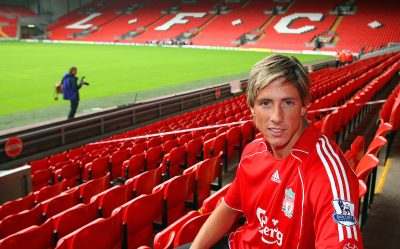
Liverpool, England – Wednesday, July 4, 2007: Liverpool’s new signing Fernando Torres at Anfield following his £26m transfer from Atletico Madird, a club record transfer fee. (Photo by David Rawcliffe/Propaganda)
At this point, the promises they had made were yet to be proven empty, and talk of a new stadium and the financial power to compete with Abramovich’s Chelsea was tantalising to a fanbase who were, as we are now, desperate for a Premier League title.
The signing of Torres seemed to back that up. The club’s new record signing at £20million, which wouldn’t get you half a Wan-Bissaka these days if rumours are to believed, was a typical “statement signing”.
The Spaniard, a hero at his boyhood club Atletico Madrid, was given the famous number nine shirt, and backed by Rafa Benitez to spearhead a realistic title challenge in the 2007-8 season.
“He has experience. He was playing in the first division at 17 years old and I think he can manage the pressure”, Benitez said.
“He knows he will be an important player and I’m sure the staff and other players will help him.
“He has power, pace, is good in the air, scores goals, can dribble and do a lot of things. The kind of striker he is different to the other strikers we have at the moment.”
Indeed, many of those strikers were jettisoned the same summer. Robbie Fowler called time to his second spell with The Reds, joining Cardiff City. Djibril Cisse, the previous record signing, left for Marseille. It was clear from the outset that Torres would be leading the Liverpool frontline, and he took to the task with aplomb.
A difficult debut at Villa Park ended in a win thanks to a remarkable last-gasp Steven Gerrard freekick, before Torres made his Anfield bow against Chelsea, the team who had tried to prise him from Atletico a few years prior. You can probably picture it now, can’t you?
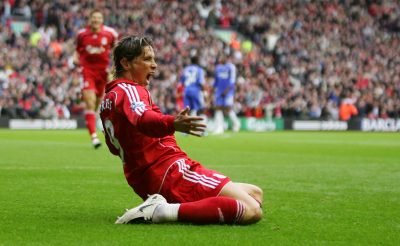
Liverpool, England – Sunday, August 19, 2007: Liverpool’s Fernando Torres celebrates scoring the opening goal against Chelsea during the Premiership match at Anfield. (Photo by David Rawcliffe/Propaganda)
Gerrard fizzes a ball into his feet. On the edge of the box, the striker feints past Tal Ben Haim with disdainful ease, leaving the full back scrambling. A clinical finish past Petr Cech, and El Nino had announced himself.
The swagger of that first goal was no one off. Fernando hadn’t taken long to realise that, outside of the big names, the quality of defenders in the Premier League would seldom be enough to stop him.
Rafa, as usual, had been right. The guile, quality and speed of Torres was a breath of fresh air, and something Liverpool had lacked for a long while.
The ability to run in behind defenders suited the passing abilities of Xabi Alonso and Gerrard perfectly, and the telepathic relationship between the captain and the forward would develop beautifully over the course of the next two seasons.
His Champions League exploits would only endear him further to the Anfield faithful. A ridiculous goal against Marseille sticks in the memory, Torres feinting and gliding his way through the opposition, sliding it into the corner in a fashion that already looked so typical.
Goals against Inter Milan and Arsenal still feel like yesterday. The effortless turn, touch, that unerring volley into the corner. Here was a man who could score any type of goal, destroy any type of defender.
The mixture of craft and graft is one so potently appreciated by fans. While Torres looked slight, and his long hair would always give the misconception that he was “soft”, his grit and mentality completely contrasted the stereotypical image of a “fancy foreign striker”.
With his back to goal, Fernando had the touch, strength and composure to match. His unpredictability and incredible use of his body meant that he could leave defenders clutching at air, and the typically rough treatment of English defenders did little to put him off.
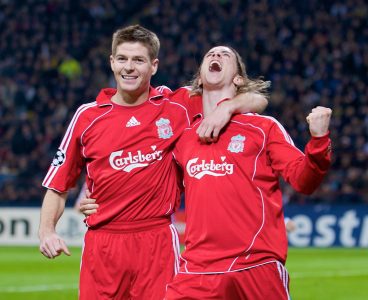
MILAN, ITALY – Tuesday, March 10, 2008: Liverpool’s Fernando Torres celebrates scoring the opening goal against FC Internazionale Milano with team-mate captain Steven Gerrard MBE during the UEFA Champions League First knockout Round 2nd Leg match at the San Siro. (Pic by David Rawcliffe/Propaganda)
Platitudes about his love of the club seemed to come from a place of true sincerity, backed up by the suggestion he took a pay cut to join The Reds. Leaving Atletico, whom he had joined as a schoolboy, was a massive decision. He was the club’s youngest ever captain, fulfilling the boyhood dream of any young football fan, but by the end of the 2007-8 season, he was Liverpool’s.
Once again, looking through the prism of the modern day, Torres’ achievements in his first season may look diminished in comparison to the 44-goal masterclass that Mo Salah delivered in his debut season.
But this was before the age of the super striker, when scoring 20 league goals in a season was considered the mark of a world-class talent. A goal every other game was the benchmark to meet, whereas now the two players that tend to finish seasons with more goals than games played have skewed the expectations.
Fernando’s 24 league goals made him the first player to reach that magical 20-goal mark for The Reds in over a decade, the last being Robbie Fowler in 1996. What’s more, his overall tally of 33 goals entered him into an elite bracket, becoming only the 10th Red in history to manage over 30 in a season.
Torres made the Fifa World 11, and scored the winning goal as Spain clinched the European Championship against Germany. It seemed that Liverpool finally had a world-class striker to complement their illustrious captain.
However, the 2008-9 season was a disjointed campaign for El Nino and one that ultimately ended in heartbreak for the club. Hamstring strains that proved to be easily aggravated restricted him to just 24 league appearances.
His moments on the pitch were still punctuated by class, and he produced some vintage performances despite a lack of fluidity and form.
His showing against Real Madrid at Anfield remains one of the finest number nine performances I can remember. Aggressive and determined against his old rivals, Torres tormented Pepe and Sergio Ramos, opening the scoring in a stunning 4-1 win.
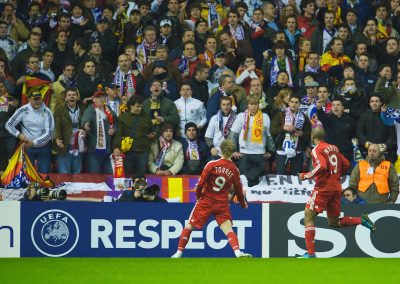
LIVERPOOL, ENGLAND – Tuesday, March 10, 2009: Liverpool’s Fernando Torres celebrates scoring the opening goal against Real Madrid during the UEFA Champions League First Knockout Round 2nd Leg match at Anfield. (Photo by David Rawcliffe/Propaganda)
His two late goals against Chelsea showed his penchant for movement and clinical finishing, whilst another brace against Arsenal in the infamous 4-4 showcased his strength and aerial ability.
Oh, and he broke Nemanja Vidic, pouncing on the Serbian’s hesitation to leave him in a heap during a landmark win at Old Trafford. As Torres wheeled away in celebration, he made the famous “five times” gesture towards the crowd. Liverpool fans tend to find that quite endearing.
The glut of draws during the winter would ultimately prove crucial as Liverpool ended the season in second place. Regardless of what many will tell you about Benitez’s rant causing Liverpool’s downfall, the absence of Torres in games against lower-class opposition was telling.
His contribution while on the pitch told you everything you needed to know as he rattled in a respectable 17 goals, but the restricted role he was forced to play no doubt had an impact.
The 2009-10 season told a similar story. Torres, who had been rewarded with a new contract in the summer, was again blighted by injuries and fatigue. However, his performances and goals meant that his reputation still remained incredibly high with the fans. He wasn’t to blame for his availability, and the effort and class he showed when he could get on the pitch hadn’t diminished.
Worryingly though, things were crumbling around him. The disingenuous intentions of the two owners were finally becoming clear, and Benitez was becoming an increasingly frustrated figure as he attempted to fight against the tide. Xabi Alonso, a fellow Spaniard and fan favourite to this day, had departed under acrimonious circumstances. Emiliano Insua was about to start 43 games in a season. Something wasn’t right.
Liverpool would go on to finish in seventh place, dropping out of the top four for the first time since 2005. This time there was no European Cup to celebrate. Wheels were in motion that would take The Reds away from the top table, and Benitez would leave his position just a week after the season concluded.
Despite only playing 22 league games, Torres notched 18 goals, including his 50th in the league. Amid a terrible season for the club and the looming spectre of debt, we were witnessing a record breaker, as he became the fastest Liverpool player to reach the milestone in club history.

Liverpool’s Fernando Torres celebrates scoring his 50th goal for the club, in record time, during the Premiership match against Aston Villa at Villa Park. (Photo by: David Rawcliffe/Propaganda)
And therein lay the problem for Fernando. Rather than spearheading a team of high-level talent, he was becoming a diamond in the rough, surrounded by mediocrity in a club that was going backwards.
At the time of signing, The Reds were a resurgent power and European Cup finalists. With a top manager at the helm in Benitez and one of the finest players in world football in Gerrard, it seemed that some solid squad building would be enough to maintain their level at the very least, while the new owners were promising a radical improvement and investment into the club at all levels.
Perhaps it was the excitement of the new project, but Torres ingratiated himself in Liverpool culture in a way that few foreign imports had before. His performances, full of heart and quality, were allied to the spirit of a working-class boy who had fulfilled his dreams by coming to Liverpool. He was taken in by the fans as one of them, and appeared to reciprocate the affection, though it took him by surprise.
“At Liverpool, there was no reason for this relationship to develop the way it did. How many players have signed for Liverpool, they go there and play and pass the years but nobody remembers what they did? I was lucky. They did not have any reason to love me that way but they made me feel different to any other player,” Torres told Simon Hughes in his book Ring Of Fire.
Torres remarked in the same interview that the club he left was not the club he joined. The breakup of the “best midfield in the world” and the loss of Benitez hit Fernando hard, and although he verbally reinstated his commitment to Liverpool before the 2009-10 season, things were different and the momentum of the club had changed direction.
Behind the scenes, the two owners were pulling in different directions. Administration and a points deduction were threatening to become a real possibility. On the pitch, things were just as desperate.
Benitez had been replaced by Roy Hodgson, who seemed to have no grasp of the principles and expectations at Liverpool Football Club, let alone the tactical ability to get the maximum output from his stars. The opening six games yielded a total of seven points – the worst start to a season in Liverpool’s premier league history.
Torres could still find the net, but not the enthusiasm and love he once had for the club. His body language had clearly changed as he looked around desperately at some of the questionable new recruits, pining for the quality of a few years prior, just as the fans were. There were glimpses of quality, but the player who scored 33 goals in his debut season was barely recognisable.
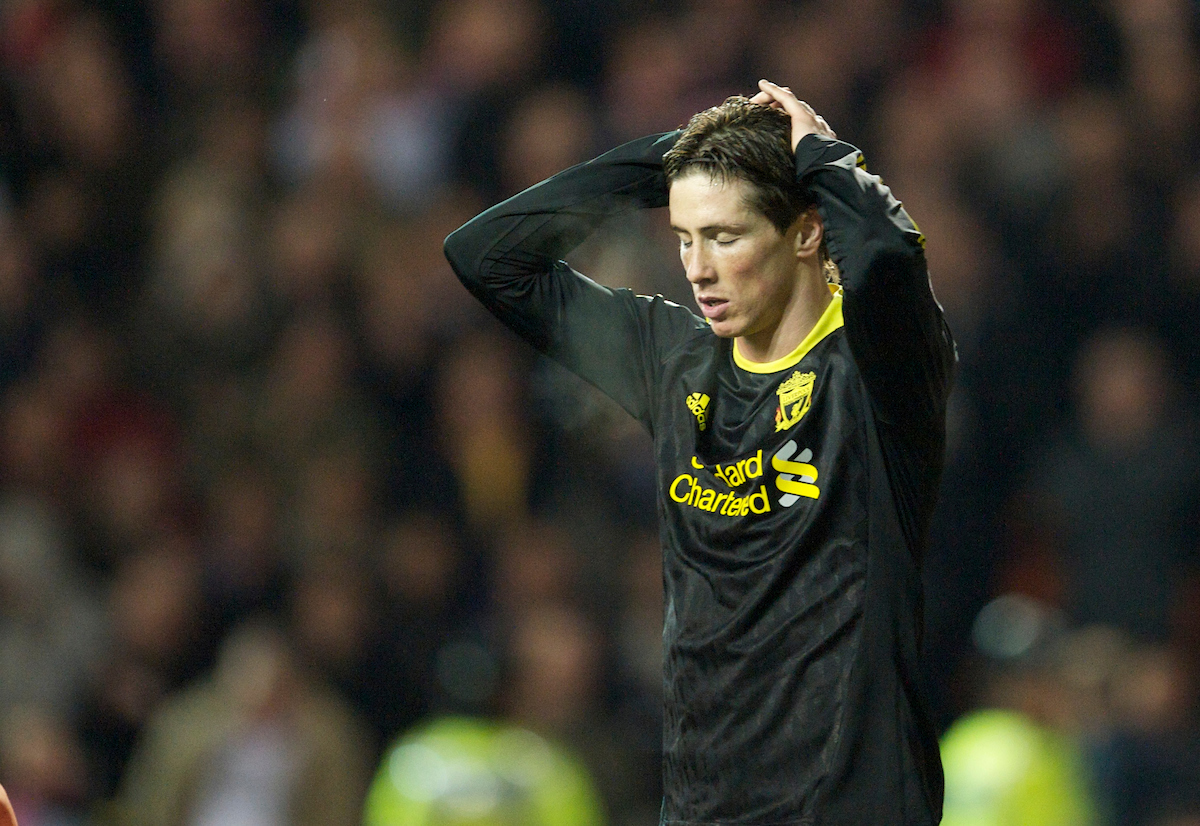
By now, we all know the story of his exit. Rumours, followed by a transfer request, followed by a £50 million move to Chelsea that still hurts to think about. The player that Torres was, the unstoppable force, seemed to be a thing of the past. In truth, the deal was a good one from a business point of view, but the emotional ties were not easily severed.
Time heals all wounds. The sense of perspective has been key to the resurgence of Torres’s popularity at Anfield. When he left, the club existed in a vacuum of negativity, with desperate and broken fans aiming their ire at players and fellow supporters alike. At the time, the sense of betrayal was too much, because the love that had been afforded to Fernando was so exceptional, so unique.
Today, as he announces his retirement, there is genuine warmth emanating from Merseyside. We remember the boyish good looks, the goals. The stunning combination of balance, power and speed. There is an understanding that his “betrayal” was merely a reaction to his own sense of injustice.
The Hicks/Gillett/Hodgson period was brutal and challenging for fans, but it’s easy to forget that the players are human too. As time goes on, there is a realisation that Torres gave his best years to Liverpool and aside from the obvious financial rewards, got nothing back from them but broken promises.
What he gave us, though, were breath-taking moments and goals that can be replayed for years. For young people like me, he gave us a hero to worship.
So happy retirement Fernando, and thanks for the memories. Thanks for United, for Milan. Thanks for Chelsea, Blackburn and Marseille.
I might even dig out the posters.
For instant reaction to all the Liverpool news and events that matter to you, SUBSCRIBE to TAW Player…
“What a finisher he was, just a player that seemingly always made the right decision in the box.” 🇪🇸
“He was always in space, his movement was brilliant and his link up with Gerrard was phenomenal.” 🔴
✍🏻Subscribe to listen to our @Torres special: https://t.co/JaNSChm2u9 pic.twitter.com/9WqQqxU5vT
— The Anfield Wrap (@TheAnfieldWrap) 20 March 2018
Recent Posts:
[rpfc_recent_posts_from_category meta=”true”]
Pics: David Rawcliffe-Propaganda Photo

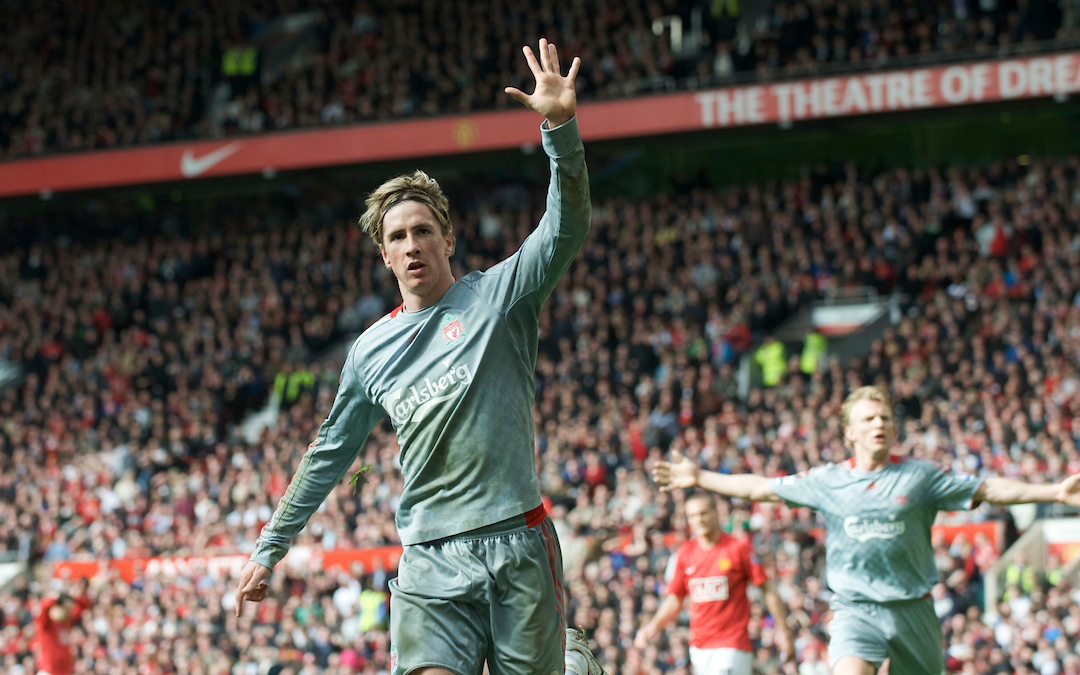










Liverpool’s last great No.9? There is a generation who missed Torres who do not know what a St John, Rush, Alderidge, Fowler, Owen, Torres et al can do for a team.
I love our current crop, and it feels heresy to whisper it, but I’d love to see us sign another Torres. We would be nailed on for the league.
To see him play and score in his prime for the reds was a joy to behold. I’m old enough to remember the ones that went before him but El Niño was just a bit different and from his first goal he made ‘that connection with the fans’. The Blackburn goal was sublime but so was the 5 finger salute to the knuckle draggers at OT in 09. Went off him when he went to Chelsea and can’t say I was dissapointed when it did not work out for him at the Bridge. I have though mellowed with time and always know he was a red rather than a blue. May well just stick on that Blackburn goal again. For old times sake.
I was at the Blackburn game and wondered at his goal – better than Van Basten. I was at Reading where the officials allowed him to assaulted for 90 minutes but he faced the fouling bastards and proved he was a hard as nails. Fernando was a great player and deserves to be spoken of with respect for what he gave our club. His departure was acrimonious but even Stevie said ‘yes’ before thinking again.
Thanks El Niño and good luck.
Fernando Torres was a absolute god send to Liverpool I’m Australian and My mum is from Mersyside we love the & i have been watching since the 70’s. I have never commented on anything online before. this man deserves a comment. He was the best at the time. when he went back to Atletico he outscored griesman on time on the field per goal. he didn’t loose anything like people think. the move to chelsea was always a mistake. i knew it the second he went. he never did a thing to disrespect liverpool. when you watch the steven gerrard story he was going to leave twice for money only. Fernando has finally done an interview about why he left liverpool years later. he and pepi were told they were the past of liverpool not the future. By the current management. He was just two much of a gentlemen to say it at the time two much respect for the club he still loves. He is always such a good man, a guy to be respected, pays tax, doesn’t sleep with his team mates wives. He is a man that little kids in the sport should look up two. He was great in the air, deceptively fast, he was a centre forward, he didn’t wait up the front for the ball he made things happen, opposition feared him, he was great with both feet. Just a great man in general. So underrated and deserved a lot more respect and attention than he ever got, some players, the wrong players get more than they deserve. He was plagued by injuries because he drew some many defenders and there really wasn’t anybody to pull defenders away up the front, it was him, with gerrard sitting behind. what he did for liverpool and atletico, not to mention spain. he is much more of a hero than he was ever given credit for. For members of my family Fernando…. your the best we ever saw, you made me love getting out of bed in the middle of the nite screaming at the tv, watching every game…… you will always be a legend and a great person……
Not sure why (probably an age thing) but I enjoy the written stuff even more than the podcasts etc. More of this sort of thing please TAW!! Torres was amazing & I dont think he was a bad sort of fella. Just a pity he was at our club during it’s most ridiculous period. Still, we’re going in the right direction now. We won it 6 times.
He should have stayed at Liverpool. He should have played with Suarez under Dalglish… Anyways £50m for him was a good price at the time as he probably was on the decline.
Yes you’re right actually, I do think he let Kenny down. Imagine what he could have done with Suarez & Torres . Still, what’s done is done & we move onwards.
This is the last thing ill say and not trying to get into a thing or disrespect anybody. if you look it up kenny let fernando down big time, not the other way around and pepi rainer neither of them were past it at the time…. pepi stayed after that but Fernando couldn’t. it was just before the transfer window was up. I loved Kenny watched him coach up in the 70’s and 80’s and his heyday… should have stayed retired.. he did nothing and seemed to get rid of every good Spanish player we had… Fernando wanted to stay at Liverpool and Retire at Altetico. the style of play of chelsea didn’t suit him and was never going two. he looked miserable the first second because he was. He was treated pretty badly two when he left lets remember. Again, it is now online to read if you care to have a look or read. He didn’t do a thing, the wrong thing was done to him by liverpool. Sqaurez went to liverpool to play with Fernando.
we are all entitled to opinion about who are favourite players are, who we think are better what we prefer but an opinion is never more important than a fact. just suggesting you get both sides, as that is now available to read about. there is no way many players would have stayed after how he was treated and what a way to treat a guy who had been the main star for us and with gerrard and alonso, disgraceful behaviour from kenny, lost a lot of respect for him since that time. he wasn’t successful with livepool next time round, should have stayed the legend he was and retired. That is fair sorry and i always loved him. i am also fair and logical two.
Thankfully in my opinion we now have Jurgen Klopp who is a man i admire and can’t say enough good thinks about what a man, smart, handles the media with grace, players love him, he loves them. there’s a manager…. best in a long time in my opinion… so happy to see liverpool playing the way they are… will always be sad i never got to see fernando at Anfield, was always a dream for me…. enough said all the best to you Fernando Torres…. liverpool’s number 9
Forgot to say, he also gave us a boss song…. Bounce !!! :D
Thank you for putting it out there so straight and true. I so wish all Liverpool fans can read this. Am in tears now. Allowed himself to be overplayed, never recovered properly but as he said ‘if football was a drug, I would b dead from overdose’
So happy to see someone who took the trouble to read up on what really went on before Torres left, broken promises, he trusted K most of all. He was made the scapegoat.
What a brilliant read. Thanks